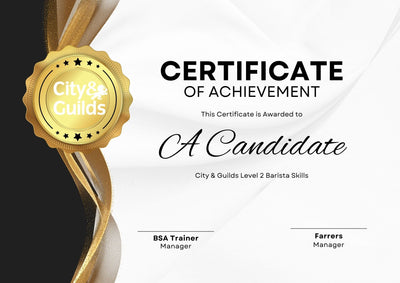Olmes Garcia, Caldas, Colombia
Farrer’s not only have a long coffee heritage, but their small, dedicated team have the drive and vision to bring you the very best ethically sourced coffees from around the globe.
Farrer’s is introducing a new and intoxicating coffee from Caldas part of the Paisa region of Colombia.
Olmes de Jesus García has been producing coffee at Finca El Topacio for over 35 years, which he grows on the fringes of a tropical rainforest, in rich volcanic soils, at above 1500 metres, on the lower slopes of the Colombian Central Mountain Range, part of the Andes.
Finca EL Topacio, grows Castillo, a hybrid coffee variety. The fruits of the Castillo coffee tree tend to be slightly larger, which means that the variety generally scores highly in cupping evaluations.

(Image by @0fernanda7 on Unsplash: https://unsplash.com/photos/XV4XUU7gWlk)
So far, seven additional cultivars have been developed from Castillo, each trying to retain the cup quality of Cattura and the disease resistance from the Timor Hybrid.
The cultivars Castillo Naranjal, La Trinidad, El Rosario, Pueblo Bello, Santa Barbara, El Tambo, and Paraguaicito can be found in different parts of Colombia, and each is adaptable to the diverse climates found across its regions.
Olmes inherited the farm from his parents, who started the business located in Caldas, at the heart of the Paisa region, parts of which sit in the ‘Eje Cafetero,’ also known as Colombia’s Coffee Triangle. ‘Eje Cafetero’ is the very heart of Colombia’s coffee industry and grows the vast majority of the high-quality coffee the country produces.
Coffees grown in the central regions (Caldas, Quindío, Risaralda, North of Valle, Antioquia, Cundinamarca and North of Tolima) are celebrated for their overall balance and their fruity, herbal notes. Flavour variations highlight the specific characteristics of each micro-region.
Another distinguishing feature of Colombian coffee production is the mitaca crop – a second harvest that occurs roughly 6 months after the main crop in most regions. The mitaca crop is a result of moist ocean air rising from both the Pacific and the Caribbean and the north-to-south orientation of the central cordilleras (mountain ranges). Colombia is one of only a few countries in the world that has this feature of production.

(Image by @herickson7 on Unsplash: https://unsplash.com/photos/2Q9zeNBoxA8)
During the harvest at Finca El Topacio, Olmes and his family, selectively handpick ripe, red cherry to ensure only the highest quality coffee is produced. They seal the cherry in airtight barrels and anaerobically ferment them for 96 hours. Following fermentation, the cherries are laid out to sun dry, during which they are raked frequently to ensure even drying.
Castillo delivers a fruity adventure in the cup, with a full body and pleasant sweetness, dark chocolate, hints of berry and stone fruits, including raspberry and cherry, with subtle red wine notes to finish.
Farm: Olmes de Jesus García and family, Finca El Topacio
Country: Colombia
Region: Caldas department, Paisa region
Varietal: Castillo
Process: Anaerobic Natural
Profile: Dark chocolate, cherry, raspberry, red wine notes
Cup Score: 88





